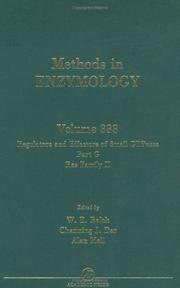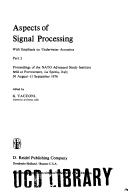| Listing 1 - 10 of 15 | << page >> |
Sort by
|

ISBN: 9780906048047 0906048044 Year: 1979 Publisher: Stevenage : Peregrinus [for] the Institution of Electrical Engineers,
Abstract | Keywords | Export | Availability | Bookmark
 Loading...
Loading...Choose an application
- Reference Manager
- EndNote
- RefWorks (Direct export to RefWorks)
Telephone --- Signaling.
Book

Year: 2017 Publisher: Bruxelles: UCL. Faculté de médecine et de médecine dentaire,
Abstract | Keywords | Export | Availability | Bookmark
 Loading...
Loading...Choose an application
- Reference Manager
- EndNote
- RefWorks (Direct export to RefWorks)
Book
Year: 1999 Publisher: Bruxelles: UCL. Faculté de pharmacie et des sciences biomédicales,
Abstract | Keywords | Export | Availability | Bookmark
 Loading...
Loading...Choose an application
- Reference Manager
- EndNote
- RefWorks (Direct export to RefWorks)
Interleukin-9 --- Suppressor of Cytokine Signaling Proteins --- Cytokines
Book
Year: 2016 Publisher: Bruxelles: UCL. Faculté de pharmacie et des sciences biomédicales,
Abstract | Keywords | Export | Availability | Bookmark
 Loading...
Loading...Choose an application
- Reference Manager
- EndNote
- RefWorks (Direct export to RefWorks)
Outre un cytosquelette cortical bien structuré et fortement ancré à la membrane, le globule rouge (GR) jouit d’une concentration en calcium intracellulaire ([Ca2+]i) finement contrôlée , impliquée dans sa déformation et sa destruction et dérégulée dans plusieurs formes d’anémies héréditaires. Grâce à l’imagerie confocale vitale de GRs, le laboratoire d’accueil a découvert que plusieurs classes de lipides du feuillet externe de la membrane plasmique (phosphatidylcholine [PC], sphingomyéline [SM], ganglioside GM1 et cholestérol) s’organisent en domaines submicrométriques partiellement reliés spatialement. Cette démonstration a été permise grâce (i) à l’insertion d’analogues lipidiques fluorescents (BODIPY-PC, -SM et - GM1) à la membrane plasmique, ou (ii) au marquage direct de lipides endogènes (SM et cholestérol) avec des fragments non toxiques de toxines spécifiques (lysénine et theta, respectivement). Mon projet s’intéresse à l’importance des domaines lipidiques pour la déformation des GRs, via le recrutement et/ou l’activation de protéines impliquées dans les échanges de Ca2+. Le premier objectif de mon mémoire a consisté à évaluer l’importance du Ca2+ pour l’organisation de la membrane des GRs en domaines lipidiques. J’ai tout d’abord déterminé en microscopie vitale à fluorescence l’abondance des domaines enrichis en SM (mis en évidence par le BODIPY-SM ou la lysénine) après stimulation de l’influx (par un ionophore, le A23187) ou de l’efflux de Ca2+ (par incubation dans un milieu dépourvu de Ca2+ par l’EGTA augmente d’un facteur trois l’abondance des domaines enrichis en SM. Cet effet est spécifique de certains domaines lipidiques puisque seuls les domaines enrichis en SM ou en ganglioside GM1 sont augmentés, mais pas ceux enrichis en cholestérol ou en PC. La suite de mon mémoire s’est donc focalisée sur les domaines enrichis en SM. J’ai ensuite étudié l’importance des domaines enrichis en SM pour les échanges de Ca2+. Dans ce but, j’ai tiré profit de l’observation que ces domaines (i) disparaissent suite au traitement à la sphingomyélinase ou à la métyl-B-cyclodextrine, des agents qui déplètent respectivement le contenu membranaire en SM et en cholestérol ; et à l’inverse (ii) augmentent en nombre suite au découplage de la membrane de son cytosquelette sous-jacent par activation de la PKC. J’ai ainsi pu montrer que la disparition des domines suite au traitement de la sphingolmyélinase ou à la cyclodextrine induit une augmentation de la [Ca2+]i. J’ai également observé que l’augmentation du nombre de domaines suite au découplage de la membrane de son cytosquelette sous-jacent s’accompagne d’une diminution de la [Ca2+]i. L’ensemble des résultats de ces deux premières parties montre qu’il existe une relation inverse entre l’abondance des domaines enrichis en SM et la [Ca2+]i. Pour ensuite tenter d’établir s’il existe une relation entre les domaines lipidiques, la [Ca2+]i et la déformabilité des GRs, j’ai travaillé sur des GRs de patients atteints d’elliptocytose et de sphérocytose héréditaires, deux maladies de fragilité membranaire des GRs. Alors que la régulation des échanges de Ca2+ est affectée chez les GRs elliptocytotiques, le nombre de domaines n’est pas significativement modifié. Chez les GRs sphérocytotiques, le nombre de domaines et les échanges de Ca2+ sont affectés de manière inversement proportionnelle, suggérant que l’organisation de la membrane en domaines enrichis en SM et la [Ca2+]i pourraient jouer un rôle dans la déformabilité des GRs. J’ai enfin commencé à rechercher par quel mécanisme Ca2+ pourrait moduler les domaines enrichis en SM. Avec l’aide des doctorants du groupe, j’ai notamment évalué si une modification de la [Ca2+]i pouvait avoir des conséquences sur (i) l’asymétrie membranaire (translocation de la phosphatidylsérine au feuillet externe mis en évidence par marquage à l’Annexine V fluorescente), ou (ii) la fluidité membranaire (mesurée par insertion du laurdan à la membrane plasmique du GR). En conclusion, les données obtenues au cours de ce mémoire ont permis de montrer la relation entre [Ca2+]i et l’organisation de la membrane en certains domaines lipidiques, ceux enrichis en SM et en ganglioside GM1. D’autre part, mes résultats suggèrent une relation entre les domaines, les échanges de Ca2+ et la déformabilité du GR. Cette étude ouvre de nombreuses perspectives en biophysique. Besides a well-structured cytoskeleton strongly anchored to the membrane, the red blood cell (RBC) exhibits an intracellular calcium concentration [Ca 2+]i finely controlled, involved in RBC deformation and destruction and deregulated in several forms of hereditary anemias. Using vital confocal imaging of RBCs, the host laboratory discovered that several types of lipids (phosphatidylcholine (PC), sphingomyelin (SM), ganglioside GM1 and cholesterol) are organized into spatially connected submicrometric domains at the outer plasma membrane leaflet. This discovery was made possible thanks to (i) incorporation at the plasma membrane of fluorescent lipid analogs (BODIPY-PC, -SM and –GM1), or (ii) direct labeling of endogenous lipids (SM and cholesterol) with non-toxic fragments of specific toxins (lysenin and theta, respectively). My project focuses on the importance of lipid domains for RBC plasticity, through the recruitment and/or activation of proteins involved in the exchange of Ca2+.The first aim of my master thesis was to assess the importance of Ca2+ in the organization of RBC membrane lipids into domains. I first determined by vital fluorescence microcopy the abundance of domains enriched in SM (highlighted by plasma membrane insertion of BODIPY-SM or decoration of endogenous SM by lysenin) after stimulation of the Ca2+ influx (by the ionopohore A23187) or efflux (by incubation in medium lacking Ca2+, in combination or not with a chelation by EGTA). Thanks to those agents, I showed that a stimulation of Ca2+ efflux by EGTA strongly increases the number of SM-enriched domains. This effect is specific to some lipid domains since only the ones enriched in SM or GM1 are increased, whereas those enriched in cholesterol or PC are not affected. The rest of my master thesis thereby focused on the domains enriched in SM. I subsequently studied the importance of SM-enriched domains for the exchanges of Ca2 To this end, I took advantage of the observation that these domains disappear upon treatment with sphingomyelinase or methyl-13-cyclodextrin, two agents that respectively deplete the membrane content in SM and cholesterol. I was able to show that the disappearance of SM enriched domains due to these treatments induces an increase in [Ca2+]i. 1 also showed that the increased domain abundance by plasma membrane: cytoskeleton uncoupling at 4.lR complexes is linked to a decrease in [Ca2+li· All these results show thatthere is an inverse relationship between the abundance of SM-enriched domains and [Ca2+]i. To next establish whether there is a relationship between lipid domains, [Ca2+]i and RBC deformability, 1 worked on RBCs of patients suffering from hereditary spherocytosis and elliptocytosis, two RBC membrane fragility diseases. ln elliptocytosis, whereas Ca2+ exchanges are modified, the number of domains is not significantly altered. ln contrast, in spherocytotic RBCs,ca2+ exchanges are favored and the abundance of domains is increased as compared to control RBCs, suggesting that membrane organization in SM-enriched domains and Ca 2+ exchanges could play a role in RBC deformability. I finally started to examine by which mechanism Ca2+ could modulate SM-enriched domains. With the help of PhD students in the group, 1 evaluated whether a modification of [Ca2+L could affect (i) membrane asymmetry (by probing the translocation of phosphatidylserine to the outer leaflet by labeling with fluorescent Annexin V); or (ii) membrane fluidity (by laurdan insertion at the RBC plasma membrane).ln conclusion, the data obtained in this master thesis have shown the relation between [Ca2+]i and the organization of the plasma membrane in domains enriched in SM (and ganglioside GM1). Moreover, my results suggest a relationship between domains, Ca2+ efflux and RBC plasticity. This study opens up many prospects in biophysics.
Lipid-Linked Proteins --- Calcium-Binding Proteins --- Calcium Signaling
Book
ISBN: 9782877725279 9782111282803 2877725278 Year: 2013 Publisher: Paris : Errance,
Abstract | Keywords | Export | Availability | Bookmark
 Loading...
Loading...Choose an application
- Reference Manager
- EndNote
- RefWorks (Direct export to RefWorks)
Une signalétique bien conçue, c'est-à-dire inventive tout en étant respectueuse des règles de l'art, représente un vecteur discret mais fort de la communication d'un site, d'un monument, d'un musée ou d'une exposition. Elle désigne, nomme, classe et structure, par la mobilisation d'indications spécifiques, les différents éléments de l'offre, qu'ils soient d'ordre cognitif ou esthétique ou qu'ils relèvent du confort et des services associés à la visite. Mais une signalétique homogène, bien conçue et mise en place dans des emplacements judicieusement choisis, devient dans les faits un système cohérent qui structure et organise les parcours. Sa trame continue et homogène devient, ni plus ni moins, qu'un mode d'aménagement graphique de l'espace. Qu'il s'agisse des repères directionnels ou de dispositifs de signalétique conceptuelle, cet ouvrage propose, dans une première et deuxième parties, les premiers éléments publiés en langue française d'une théorie communicationnelle de ce système essentiel. Une troisième partie, plus pratique, rappelle quelles sont les étapes de conception et de mise en place d'une signalétique dans un équipement culturel. Cet ouvrage s'adresse, d'une part, aux professionnels qui mettent en place de nouveaux aménagements ou dirigent des équipements patrimoniaux et culturels dans lesquels visiteurs et usagers se perdent et s'égarent à longueur de temps, et d'autre part, aux chercheurs ou aux étudiants qui analysent les modalités de reconnaissance par les différentes catégories de public des monuments, des musées, des expositions, ainsi que des centres et des parcours d'interprétation.
Corporate image --- Arts facilities --- Entreprises --- Equipements culturels --- Signals and signaling --- Image --- Signaux et signalisation --- Arts facilities - Museum exhibits - Handbooks, manuals, etc --- Musées --- Signalisation --- 037 --- Signalisation.


ISBN: 9780817643904 0817643907 0817645403 Year: 2007 Publisher: Birkhäuser Boston
Abstract | Keywords | Export | Availability | Bookmark
 Loading...
Loading...Choose an application
- Reference Manager
- EndNote
- RefWorks (Direct export to RefWorks)

ISSN: 00766879 ISBN: 0121822346 9786611020842 1281020842 0080522564 0121822265 0121822338 0121822303 9786611011093 1281011096 0080496806 9786611020835 1281020834 0080522556 9786611011130 1281011134 0080496849 9780121822309 9780121822330 9780121822347 9780121822262 Year: 2001 Volume: 325-329-332-333 Publisher: San Diego : Academic Press,
Abstract | Keywords | Export | Availability | Bookmark
 Loading...
Loading...Choose an application
- Reference Manager
- EndNote
- RefWorks (Direct export to RefWorks)
The critically acclaimed laboratory standard for more than 40 years, Methods in Enzymology is one of the most highly respected publications in the field of biochemistry. Since 1955, each volume has been eagerly awaited, frequently consulted, and praised by researchers and reviewers alike. Now with more than 300 volumes (all of them still in print), the series contains much material still relevant today-truly an essential publication for researchers in all fields of life sciences.This volume and its companions (Volumes 255, 256, 257, and the forthcoming 325, 329,
Guanosine triphosphatase. --- ras Proteins. --- ras Proteins --- Monomeric GTP-Binding Proteins --- GTP-Binding Proteins --- Intracellular Signaling Peptides and Proteins --- Peptides --- Carrier Proteins --- GTP Phosphohydrolases --- Proteins --- Amino Acids, Peptides, and Proteins --- Acid Anhydride Hydrolases --- Chemicals and Drugs --- Hydrolases --- Enzymes --- Enzymes and Coenzymes --- Ras proteins. --- G proteins. --- GTP-binding proteins --- GTP regulatory proteins --- Guanine nucleotide-binding proteins --- Guanine nucleotide regulatory proteins --- Guanosine triphosphatase --- Guanosine-trifosfatase --- Guanosinetriphosphatase --- Trifosfatase [Guanosine-] --- Triphosphatase [Guanosine] --- rho GTP-Binding Proteins --- Binding Protein --- Binding Proteins --- Transport Proteins --- Protein, Binding --- Proteins, Binding --- Proteins, Carrier --- Proteins, Transport --- G-Protein --- GTP-Binding Protein --- GTP-Regulatory Protein --- Guanine Nucleotide Coupling Protein --- G-Proteins --- GTP-Regulatory Proteins --- Guanine Nucleotide Regulatory Proteins --- G Protein --- G Proteins --- GTP Binding Protein --- GTP Binding Proteins --- GTP Regulatory Protein --- GTP Regulatory Proteins --- Protein, GTP-Binding --- Protein, GTP-Regulatory --- Proteins, GTP-Binding --- Proteins, GTP-Regulatory --- Intracellular Signaling Peptides --- Intracellular Signaling Proteins --- Peptides, Intracellular Signaling --- Proteins, Intracellular Signaling --- Signaling Peptides, Intracellular --- Signaling Proteins, Intracellular --- P21 (rho)Protein --- rho GTP-Binding Protein --- rho Protein P21 --- rho G-Proteins --- rho GTPases --- rho Small GTP-Binding Proteins --- G-Proteins, rho --- GTP-Binding Protein, rho --- GTP-Binding Proteins, rho --- GTPases, rho --- P21, rho Protein --- rho G Proteins --- rho GTP Binding Protein --- rho GTP Binding Proteins --- rho Small GTP Binding Proteins --- GTP Phosphohydrolase --- GTPase --- GTPases --- Guanosine Triphosphate Phosphohydrolases --- Guanosinetriphosphatases --- Phosphohydrolase, GTP --- Phosphohydrolases, GTP --- Phosphohydrolases, Guanosine Triphosphate --- Triphosphate Phosphohydrolases, Guanosine --- ras-Related G-Proteins --- ras-Related GTP-Binding Proteins --- G-Proteins, Monomeric --- GTP-Binding Proteins, Monomeric --- Monomeric G-Proteins --- Small G-Proteins --- Small GTPases --- ras-Related GTPases --- G Proteins, Monomeric --- G-Proteins, Small --- G-Proteins, ras-Related --- GTP Binding Proteins, Monomeric --- GTP-Binding Proteins, ras-Related --- GTPases, Small --- GTPases, ras-Related --- Monomeric G Proteins --- Monomeric GTP Binding Proteins --- Proteins, ras-Related GTP-Binding --- Small G Proteins --- ras Related G Proteins --- ras Related GTP Binding Proteins --- ras Related GTPases --- Anhydride Hydrolases, Acid --- Hydrolases, Acid Anhydride --- Biochemistry -- Periodicals. --- Biochemistry -- Technique. --- Enzymes -- Collections. --- Enzymes -- Periodicals. --- Enzymologie -- Technique -- Collections. --- GTP Phosphohydrolases. --- GTP phosphohydrolase --- Guanosine triphosphate phosphohydrolase --- GTP phosphohydrolases. --- Cytoplasmic Vesicles --- Physiological effect --- G proteins --- Membrane proteins --- Phosphatases --- Coenzymes and Enzymes --- Biocatalysts --- Molecular Mechanisms of Pharmacological Action --- Protein Binding --- Receptors, Transferrin --- Gene Products, Protein --- Gene Proteins --- Protein Gene Products --- Proteins, Gene --- Polypeptides --- Biocatalyst --- Enzyme --- Carrier Protein --- Transport Protein --- Protein, Carrier --- Protein, Transport --- Protein --- Peptide --- Polypeptide --- Hydrolase --- Small GTPase --- GTPase, Small --- rho GTPase --- GTPase, rho --- Gene expression. --- Gtp phosphohydrolases --- Map kinase signaling system --- Adp-ribosylation factors --- Gtp-binding proteins --- Gtp phosphohydrolase activators --- Gtp-binding protein regulators

ISBN: 9027707987 9027707995 9027708002 9401012253 9401012237 9401053502 9401130361 9789027707987 9789027707994 9789027708007 Year: 1977 Volume: 33 Publisher: Dordrecht Boston Reidel
Abstract | Keywords | Export | Availability | Bookmark
 Loading...
Loading...Choose an application
- Reference Manager
- EndNote
- RefWorks (Direct export to RefWorks)
Electronics --- Signal processing --- Sonar --- Underwater acoustics --- Sonar. --- Acoustics, Underwater --- Hydroacoustics --- Underwater sound --- Fluids --- Sound --- Asdic --- Echo ranging --- Sound navigation ranging --- Detectors --- Electronics in navigation --- Signals and signaling, Submarine --- Ultrasonic equipment --- Processing, Signal --- Information measurement --- Signal theory (Telecommunication) --- Acoustic properties --- Signal processing. --- Underwater acoustics.
Book
ISBN: 2275011730 9782275011738 Year: 1979 Volume: t. 162 Publisher: Paris : LGDJ (Librairie Générale de Droit et de Jurisprudence),
Abstract | Keywords | Export | Availability | Bookmark
 Loading...
Loading...Choose an application
- Reference Manager
- EndNote
- RefWorks (Direct export to RefWorks)
Criminal law. Criminal procedure --- Legal theory and methods. Philosophy of law --- Signs and signboards --- Traffic signs and signals --- Symbolism in law --- Enseignes --- Signalisation routière --- Symbolisme en droit --- Law and legislation --- Droit --- 340 <44> --- -Signs and signboards --- -Symbolism in law. --- -Road signs --- Roads --- Roadside traffic signs --- Traffic control devices --- Traffic signaling --- Transportation, Automotive --- Highway communications --- Transportation markings --- Legal symbolism --- Symbolism, Legal --- Law --- Guide signs --- Guide-posts --- Guideposts --- Sign-boards --- Signage --- Signboards --- Signs --- Signs (Advertising) --- Signs and sign-boards --- Advertising --- Visual communication --- Bill-posting --- Posters --- Rechtsbeginselen. Juridische methodologie.--Frankrijk --- -Signs --- Traffic signs --- Traffic control --- Accessories --- -Rechtsbeginselen. Juridische methodologie.--Frankrijk --- -340 <44> --- 340 <44> Rechtsbeginselen. Juridische methodologie.--Frankrijk --- Signalisation routière --- Road signs --- Advertising laws --- Signs and signboards - Law and legislation - France --- Traffic signs and signals - France --- Signs and signboards - Law and legislation
Periodical
ISSN: 17518784 17518792 Year: 2007 Publisher: Stevenage IET
Abstract | Keywords | Export | Availability | Bookmark
 Loading...
Loading...Choose an application
- Reference Manager
- EndNote
- RefWorks (Direct export to RefWorks)
Covers the theory and practice of systems involving the processing of signals for radar, radiolocation, radionavigation and surveillance purposes.
Telecommunication --- Radar --- Sonar --- Signal processing --- Télécommunications --- Traitement du signal --- Periodicals. --- Périodiques --- Electronics in navigation --- Navigation --- Electronics in navigation. --- Navigation. --- Radar. --- Signal processing. --- Sonar. --- Periodicals --- Conferences - Meetings --- Engineering --- Electrical Engineering --- Télécommunications --- Périodiques --- EBSCOASP-E EBSCOBSP-E EJINGEN EPUB-ALPHA-I EPUB-PER-FT IET-E --- radar --- sonar --- radiolocation --- navigation --- surveillance --- signals --- Asdic --- Echo ranging --- Sound navigation ranging --- Detectors --- Signals and signaling, Submarine --- Ultrasonic equipment --- Underwater acoustics --- Processing, Signal --- Information measurement --- Signal theory (Telecommunication) --- Electronic systems --- Pulse techniques (Electronics) --- Radio --- Remote sensing --- Navigation, Primitive --- Locomotion --- Orientation --- Nautical astronomy --- Naval art and science --- Pilots and pilotage --- Electronic navigation --- Marine electronics --- Navigation, Electronics in --- Aids to navigation --- Electronics --- Electronics in transportation --- Ships --- Electronic equipment --- Telecommunication - Periodicals --- Radar - Periodicals --- Sonar - Periodicals --- Signal processing - Periodicals
| Listing 1 - 10 of 15 | << page >> |
Sort by
|

 Search
Search Feedback
Feedback About
About Help
Help News
News